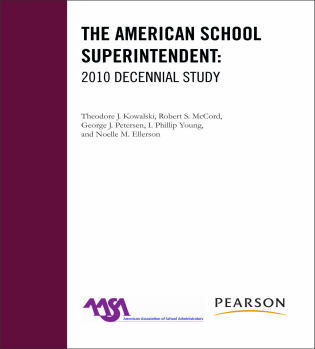The State of the American School Superintendency: 2010 Decennial Study
December 01, 2010
This report from AASA provides the largest and most comprehensive look at the men and women leading the nation's public schools.

About the Study
The American School Superintendent: 2010 Decennial Study, a must-have report published in December 2010, offers a definitive look at the state of school leadership in the United States. It provides a detailed picture of the men and women leading the nation’s schools and the districts in which they work. It is based on a representative sample of school leaders nationwide.
This study is the latest in a long series of reports on the American school superintendent, published approximately every decade since 1923. This report is a valuable resource for school leaders, aspiring school leaders, those charged with preparing and supporting school leaders, and all others who think and write about American public education.
Topics Include:
- The demographics of today’ school leaders
- Superintendents’ professional experience, preparation and training
- Superintendent/school board relations
- Working conditions of the superintendency
- Superintendent tenure
- Board evaluations and contracts
- National trends and key issues affecting education and leadership
- The history of the school superintendent in American public education.
Among the key findings in the study:
- The work portfolio of America’s superintendents is increasingly diverse, encompassing not only student achievement, but the diversification of student and staff populations, the explosion of technology, expanded expectations from the government,
the school board and the community, and the globalization of society.
- The percentage of female superintendents has increased substantially since 1992. In this study, nearly one in four respondents (24.1%) was a woman. (In 2000, the percentage was 13.2.)
- Non-minority group respondents more often entered the superintendency before the age of 46 than did their peers in the minority group. Minority group respondents were more than twice as likely as their peers in the non-minority group to report that
they had encountered discrimination in their pursuit of the superintendency.
- The level of job satisfaction expressed by superintendents remains high. A high percentage would again seek to occupy the same position if given the chance to re-live their careers.
- Only about half (51%) of the respondents said that they planned to still be a superintendent in 2015—a finding suggesting the probability of substantial turnover in the next few years.
The work is a collaboration of five authors:
Theodore J. Kowalski is professor and Kuntz Family Chair of Educational Administration at the University of Dayton.Robert S. McCord is an associate professor in the Department of Educational Leadership at the University of Nevada, Las Vegas where he co-directs the Center for Education Policy Studies.
George J. Petersen is professor and dean of the School of Education at California Lutheran University.
I. Phillip Young is a professor of education at the University of California-Davis and is co-director of a joint doctoral program involving U.C. campuses and the California State University-Fresno.
Noelle M. Ellerson is assistant director of policy analysis and advocacy at the American Association of School Administrators.
Advertisement
Advertisement
Advertisement
Advertisement



